
|

|
|
The Great White TypeBy Donna Speidel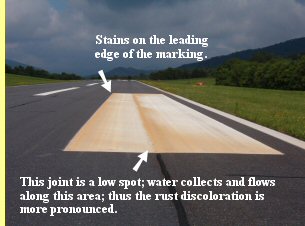
It was only a few months after we had painted the runway that we received a call from the airport. "These markings look rusty," said the airport maintenance supervisor. It wasn't the first time we had seen the problem. It seems to be common in all sections of the country and is believed to have something to do with iron sulfide contained in some asphalt aggregates. Theoretically, the iron is picked up by the rain and washed across the runway surface from center to the edges. The leading edge of the nearest marking is affected the worst, as the paint absorbs the contaminants. In this picture, there is also a low spot along the joint where water also flows and dwells.
Rust remover takes away the discoloration, but it also destroys the reflectivity of the glass beads. And the stain returns as the rust contamination on the pavement continues to be picked up by rain and washed across the marking. The pictures below show a rust discolored area. "SIGHTLINE" was lettered on the rusty area; and it turned white. But later that night, a picture shows that the rust remover also destroyed the reflectivity of the glass beads.
All of the markings were waterblasted with high pressure (8-10,000 psi) water to remove the discolored, scaling paint ("Surface Preparation") before applying the modified paint. Two years later, the markings were still white.
High pressure waterblasting is the method of choice for this kind of surface preparation, given that it is usually asphalt that is affected by this rusty problem, and other preparation methods would be too aggressive. Another airport has elected to go under the "guns" to see if the modified Type D will solve its rust issue next spring. Spring seems a long time away from now. The holidays are upon us and the weather is turning cold, the painting season is over... Or is it? See our "What's New" column about cold application 1952-D. |

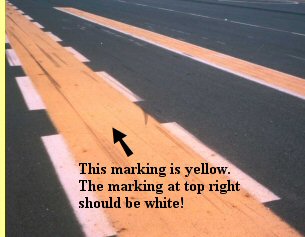 In other areas of the country, the marking discolors uniformly, with little evidence of the
rain-wash effect across the leading edge. Again, theoretically, the presence of iron sulfide in the aggregate
and in the underlying soils is higher. So the entire painted area is affected by the rust stain.
In other areas of the country, the marking discolors uniformly, with little evidence of the
rain-wash effect across the leading edge. Again, theoretically, the presence of iron sulfide in the aggregate
and in the underlying soils is higher. So the entire painted area is affected by the rust stain.

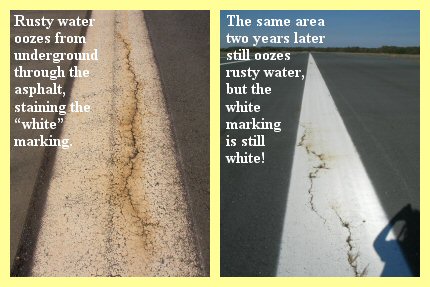 In an attempt to solve the problem, we contacted our paint manufacturer who is also a very
knowledgeable chemist. He developed a modification to the TT-P-1952D as a test at an airfield to be repainted that
had serious discoloration issues. The airport manager knew he had a problem; and was eager to see if it could be
solved.
In an attempt to solve the problem, we contacted our paint manufacturer who is also a very
knowledgeable chemist. He developed a modification to the TT-P-1952D as a test at an airfield to be repainted that
had serious discoloration issues. The airport manager knew he had a problem; and was eager to see if it could be
solved.
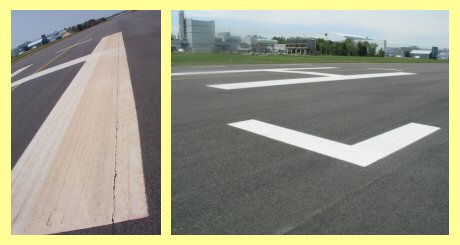 The picture on the far left, taken before the paint was applied in 2004, is the same helipad two
years later shown on the right. There is no rust discoloration, leading us to believe that the modification done to the
paint by our esteemed paint chemist will help airports plagued by this problem. The one caveat is that you must
perform surface preparation of the discolored marking before applying the modified paint.
The picture on the far left, taken before the paint was applied in 2004, is the same helipad two
years later shown on the right. There is no rust discoloration, leading us to believe that the modification done to the
paint by our esteemed paint chemist will help airports plagued by this problem. The one caveat is that you must
perform surface preparation of the discolored marking before applying the modified paint.
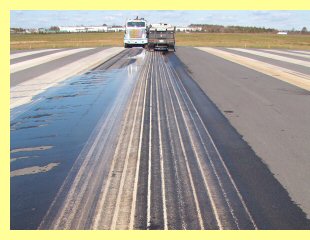 Lacking funds to clean and prepare the rusty markings on a small general aviation runway, an
agency still wanted to see if the modified 1952D would be a possible cure see applied right over the discolored
markings. The stain bled right through the fresh coat.
Lacking funds to clean and prepare the rusty markings on a small general aviation runway, an
agency still wanted to see if the modified 1952D would be a possible cure see applied right over the discolored
markings. The stain bled right through the fresh coat.